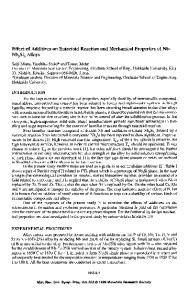Effect of high pressure during the fabrication on the thermal and mechanical properties of amorphous Ni 60 Nb 40 particl
- PDF / 207,253 Bytes
- 6 Pages / 585 x 783 pts Page_size
- 39 Downloads / 316 Views
Shankar Venkataraman, Jayanta Das, LaiChang Zhang, Wenyong Zhang, and Jürgen Eckertb) IFW Dresden, Institut für Komplexe Materialien, Postfach 27 01 16, D-01171 Dresden, Germany (Received 15 May 2006; accepted 3 August 2006)
Ni60Nb40 metallic glass particles, prepared by mechanical alloying, were used to fabricate Al–30 wt% Ni60Nb40 metal matrix composites (MMCs) at 823 K by sintering, hot pressing, and hot extrusion. The Ni60Nb40 reinforcements remained amorphous in all the MMCs fabricated by the different methods. Compression tests revealed that the Young’s modulus and yield strength of the MMCs produced by hot-pressing and hot-extrusion are higher than those for the sintered specimens. Differential scanning calorimeter (DSC) annealing of the as-produced MMCs at 913 K revealed there are severe interfacial reactions between the Al matrix and the Ni60Nb40 reinforcements. The DSC isotherms indicate that the Al matrix reacts faster with Ni60Nb40 in the hot-pressed and hot-extruded MMCs than it does in the sintered material.
I. INTRODUCTION
Metallic glasses have been drawing increasing attention in recent years due to their scientific and engineering significance.1–3 Compared to conventional metals and alloys, metallic glasses have superior properties such as high strength, hardness, and elastic strain limit, along with relatively high fracture toughness, fatigue, and corrosion resistance.4 Therefore, metallic glasses are considered promising structural materials5,6 and have already found industrial applications, such as golf clubs, mobile phone casings, and surgical instruments.7 Recently, there have been some attempts to use metallic glass as reinforcement in metal matrix composites (MMCs).8–10 It was believed that by replacing conventional ceramic reinforcements with metallic glass, the matrix-reinforcement interfacial bonding can be improved, which should lead to better mechanical properties.8,10 The first attempt was made by Lee et al.8,9 In their work, an infiltration casting method was used to
a)
Address all correspondence to this author. e-mail: [email protected] b) This author was an editor of this journal during the review and decision stage. For the JMR policy on review and publication of manuscripts authored by editors, please refer to http://www. mrs.org/jmr_policy. DOI: 10.1557/JMR.2007.0158 1168 J. Mater. Res., Vol. 22, No. 5, May 2007 http://journals.cambridge.org Downloaded: 16 Mar 2015
produce Al-based matrix composites in which Ni–Nb–Ta metallic glass, in the form of either ribbons or particles, served as reinforcements.8,9 These composites exhibit higher strength than their monolithic matrix alloys. The most important factor in fabrication of metallic glass-reinforced MMCs is to prevent the metallic glass reinforcement from crystallizing or reacting with the matrix, so the highest temperature during fabrication should be lower than the crystallization temperature of the selected glass. Considering that the crystallization temperatures for most of the available metallic glasses are typically lo
Data Loading...











